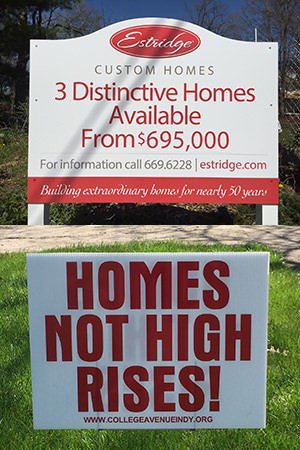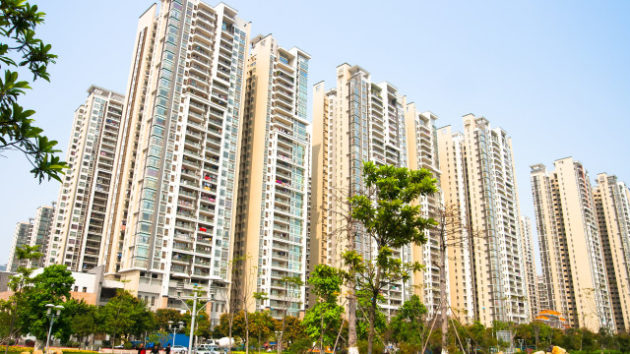How to Ruin a Neighborhood by Sarah Skwire
 Anti-development and Classist Programs Come Cloaked in Homey Slogans.
Anti-development and Classist Programs Come Cloaked in Homey Slogans.
“Distinctive Homes Available, Starting at $695,000”
“Homes, Not High-Rises”
Every day that I take my kids to school, I pass these two signs. My neighborhood is currently expanding, and some formerly vacant land across from the school building now has three well-designed and sumptuously outfitted single-family homes standing on it. Right across the street from two schools and a short bike ride away from a park, a Starbucks, and my favorite ice cream store, these homes are perfectly located for families.
About five blocks away, a new apartment building and parking garage are also under construction. The apartment building, which will have shops on the ground floor so that it fits in well with my mixed-use neighborhood, will be five stories tall and located near a busy and vibrant intersection — right by a CVS, a HopCat brewpub, and a bank. It’s walking distance from a great small music venue, several bars, a taco shop, Indian and Cuban food, a different Starbucks, and a tattoo parlor. It’s a great location for young singles or couples without kids.
And yet, as the signs in my neighborhood indicate, for a lot of my neighbors, the high-rise apartment building is a problem in a way that the new single-family homes are not.
My years living in an actual high-rise in Chicago mean that I snicker when a five-story building is referred to as a high-rise. No matter. The real concern here is that the combination of signs posted in my neighborhood highlights one of the constant challenges posed to the vibrant, mixed-use, city neighborhoods that urban activist Jane Jacobs valued so highly.
That challenge is us. That challenge is our own self-love and our own provincialism. We all think that our own ways of living, our own styles of home, and our own choices are the best ones for us. And we often (no matter how hard we try to avoid it) assume that they are also the best for everyone else.
I live in a small brick bungalow on the edge of a pricey neighborhood because I would rather have a “good enough” house in a safe neighborhood with great restaurants, parks, and schools my kids can walk to than have a much grander house in a neighborhood that doesn’t offer those things.
That’s my choice, and it reflects the way I’m living now.
But at various other points in my life, the homes that best suited my needs were a college dorm room, a room on the top floor of my coed fraternity’s house, a shared flat in Oxford, and yes, a tiny high-rise studio in Chicago.
Much as I loved those past homes, they would be inferior choices for me now that I have two kids and a steady paycheck. For me, right now, the single-family home I have is just right. And surely, for the three families who buy them, those new and distinctive $695,000 single-family homes will be just right.
That those homes are just right for some people does not mean they are just right for everyone. When people say, “homes, not high-rises,” they think they are saying, “Everyone should have a great house like I do! I can’t imagine living in an apartment!”
But they are really saying, “If you are not yet ready to afford a single-family home and all that comes with it, there is no place for you here.” They are really saying, “There’s a salary floor on living in this neighborhood and you — new graduate, or recently divorced dad, or newcomer to our city or country, or family who just wants a smaller space — you don’t cut it. Keep moving.”
It may be fine for neighborhoods to make that decision. But I think it’s important to acknowledge what’s really happening. Rather than allowing people to cloak their antidevelopment and classist programs in slogans that pretend to be concerned with cozy concepts like “home,” let’s not be shy about telling them exactly what they’re doing.
And let’s not lie to ourselves about what we’ll lose. The less mixed use my neighborhood sees, the less population density it has, the less variety of housing it offers, the less it will have of the things that make it a fun and funky neighborhood. If the rent gets too high for that amazing, cheap taco shop to turn a profit on its carnitas and carne asada, and if there’s not enough street traffic to bring customers into the Cuban sandwich place for a medianoche and a cortado, those places will disappear.
“Growth, not height restrictions and a fixed building stock, keeps space affordable and ensures that poorer people and less profitable firms can stay and help a thriving city remain successful and diverse,” writes economist Edward Glaeser in the Atlantic. “Height restrictions do increase light, and preservation does protect history, but we shouldn’t pretend that these benefits come without a cost.”
I’m not sure I’m willing to make the trade-off because some of my neighbors think that anything under 2,700 square feet can’t be a real home.
Sarah Skwire is the poetry editor of the Freeman and a senior fellow at Liberty Fund, Inc. She is a poet and author of the writing textbook Writing with a Thesis. She is a member of the FEE Faculty Network.




Leave a Reply
Want to join the discussion?Feel free to contribute!